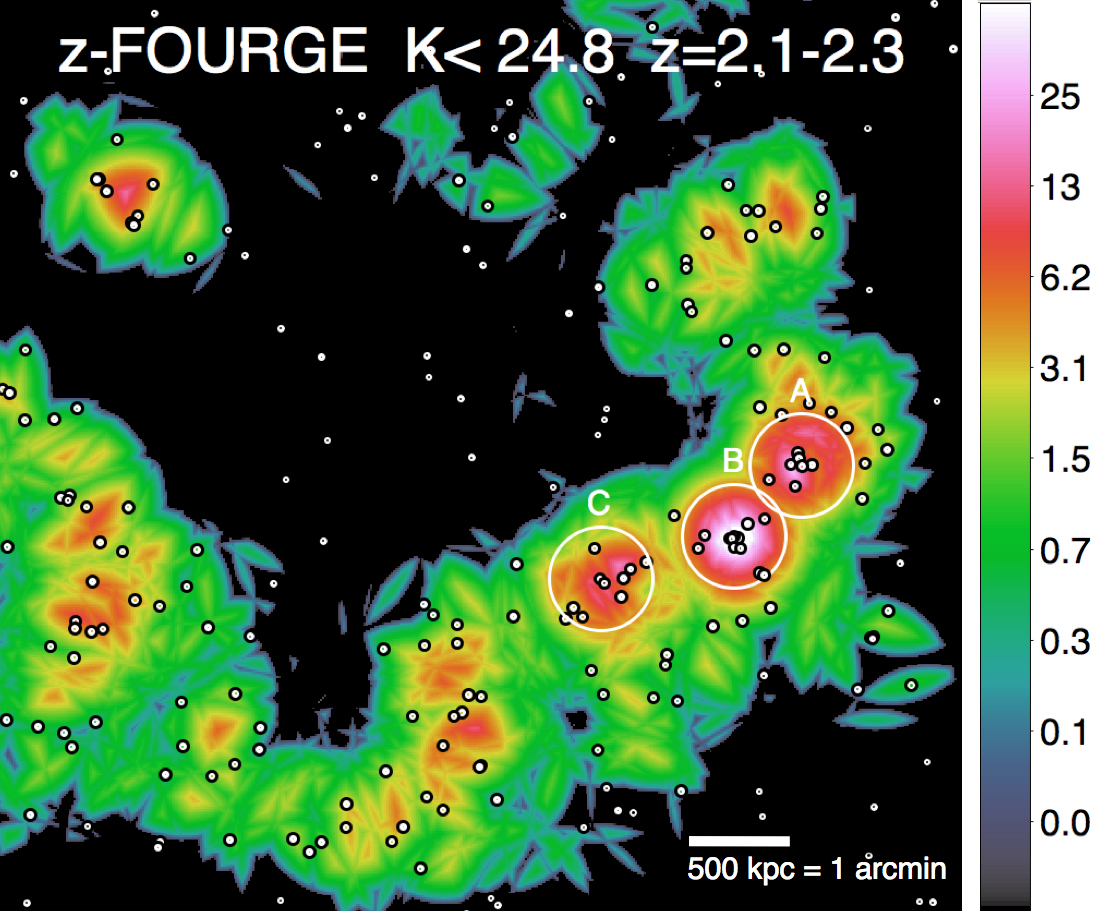A team of astronomers has discovered the most distant example of a galaxy cluster lying in the middle of one of the most well-studied regions in the sky.
Galaxy clusters are the ‘urban centres’ of the universe and may contain thousands of galaxies. This cluster is located 10.5 billion light-years away from our own Milky Way galaxy and is made up of a dense concentration of 30 galaxies that is the seed for a much bigger ‘city’.
“Our galaxy cluster is observed when the Universe was only three billion years old,” said Swinburne University of Technology astrophysicist Dr Lee Spitler, lead author of the study known as the FourStar Galaxy Evolution Survey (Z-FOURGE).
“This means it is still young and should continue to grow into an extremely dense structure containing many more galaxies.”
The discovery of this system at such an early stage of the Universe will help astronomers understand how galaxies are influenced by their environment. We see the end result of this process in nearby galaxy clusters, but it is critical to study distant clusters to develop a broad timeline of how galaxies were transformed in densely packed regions.?
“This finding is much like discovering an ancient city that existed earlier than any other known city,” said team member Professor Kim-Vy Tran of Texas A&M University.
“In the same way that it’s important for humans to search for the oldest known cities to understand civilisations today, it’s important to search for the cosmological equivalent of the most ancient cities to understand why galaxies like our Milky Way look the way they do.”
Dr Spitler said the discovery was remarkable because the cluster is located in the middle of one of the most well-studied regions of the sky. Near the star constellation Leo, this region has been carefully examined for thousands of hours using all major observing facilities on the ground and in space, including nearly one month of observing time from the Hubble Space Telescope.
Despite the significant investment of telescope time, Dr Spitler said a critical piece of information was still missing – accurate distances for faint galaxies over a large section of the sky.
“A fundamental problem in observational astronomy is to classify the points of light we see in the night sky. You need to determine if the point of light you are looking at is a star in our Milky Way, a nearby galaxy or one very far away.”
Addressing this problem is the focus of a new survey, led by Dr Ivo Labbé at Leiden Observatories in the Netherlands. Swinburne’s Professor Karl Glazebrook is leading the Australian team.
Observations are being conducted with the new FourStar camera on the Magellan 6.5-metre telescope in Chile. With five specially designed infra-red camera filters, the team members collect images that are sensitive to narrow sections of the near-infrared wavelength spectrum. With this powerful approach, they are able to measure distances to thousands of distant galaxies at a time.
From the first six months of the survey, the team obtained accurate distances for faint galaxies over a region roughly one-fifth the size of the moon as seen from Earth. Though the area is relatively small, they found roughly a thousand galaxies more than 10.5 billion light-years away.
“These new filters are a novel approach, it’s a bit like being able to do a CAT scan of the sky to rapidly make a 3D picture of the early Universe,” said Professor Glazebrook. “We can see the galaxies arranged in filaments and dense clusters very easily.”
The team is pursuing more observations using other telescopes to characterise the galaxy cluster. In February, Swinburne team members travelled to Hawaii to use the Keck Telescope, accessed through a partnership between Swinburne and California Institute of Technology in Pasadena, USA.
The findings will be published in the Astrophysical Journal Letters.
Ends
Read Professor Karl Glazebrook’s blog.


